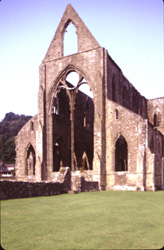 |
 |
 |
 |
 |
 |
 |
|
|
Cistercian Abbeys: TINTERN Name:
TINTERN Location: nr Chepstow County:
Gwent Tintern was founded in 1131 by Walter fitz Richard (d. 1138),
the Anglo-Norman lord of Chepstow, and a member of the powerful
family of Clare. Walter of Clare was also related by marriage to
Bishop William of Winchester, who had introduced the first colony
of White Monks to Waverley in 1128.
Tintern was the first Cistercian house to be founded in Wales and
the second in the British Isles
after Waverley.
The abbey buildings appear to have been intended for a fairly large community: some twenty monks and perhaps fifty lay-brothers. The abbey seems to have been reasonably endowed with lands and possessions on both sides of the river Wye. By the late thirteenth century the monks at Tintern were farming well over 3000 acres of arable land on the Welsh side of the Wye and kept some 3264 sheep on their pasture lands. In 1245 the lordship of Chepstow passed to the Bigod family. Roger Bigod III, Earl of Norfolk (1270-1306), took a keen interest in the abbey. In 1301-2 he granted the abbey his Norfolk manor of Acle. This proved to be a valuable asset to Tintern and by the sixteenth century was accounting for a quarter of the abbey’s income. Roger Bigod was remembered primarily as the builder of the abbey church. The project, which had commenced in 1269, was finally concluded under the patronage of Roger, c. 1301. So great was the generosity of Roger Bigod that later observers considered him to be the founder of the abbey. At the time of the Dissolution the monks were still distributing alms to the poor five times a year for the repose of Roger’s soul. The abbey was at its most prosperous at the turn of the fourteenth century but afterwards made no significant additions to its property.
Tintern was one of the few Welsh abbeys that managed to escape
the suffering inflicted by the wars of Edward II. No doubt this
was due to the fact that Tintern occupied a site that was more
remote than its Welsh counterparts and was thus outside the area
in which most of the fighting took place. Edward II was known to
have stayed at the abbey for two nights in 1326 when he was fleeing
from the invading army of Roger Mortimer, but otherwise Tintern’s
history remains a quiet one. By the early fifteenth century the
abbey was experiencing some financial difficulties as a result
of the damaging effects of the uprising of Owain Glyndwr. The community
found some cash relief from the offerings of pilgrims who travelled
to the abbey. The abbey chapel contained a statue of St. Mary the
Virgin which was thought to have possessed miraculous powers and
it was said a great number of people journeyed to visit this sight.
Today the site remains
one of the most picturesque and romantic of all the tourist sites
in Wales. The great gothic church stands almost complete, save
the roof and the north aisle in the nave. The excavated foundations
of the communal guest hall and other inner court structures can
be seen to the west of the abbey church. The north-east side of
the abbey complex does not survive to any great height but shows
the lay out of the infirmary hall and the abbot’s lodgings.
|
